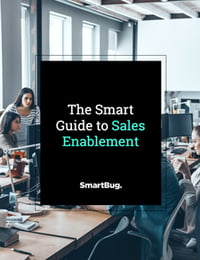
Mastering the Deal Pipeline: 5 Tactics to Boost Conversion Rates
July 28, 2023
By Jen Spencer
In today's competitive business environment, it's crucial to find effective tactics that speed up lead-to-opportunity conversion in the deal pipeline. If you're looking to maximize your sales potential and close deals faster, this blog post is for you.
We've compiled a list of five key tactics that are proven to boost conversion rates and accelerate the sales process. From analyzing entry points to defining clear criteria and leveraging automation tools, these strategies will help you streamline your pipeline and drive revenue growth. Get ready to take your sales game to the next level!
1. Understanding the Deal Pipeline
Understanding the deal pipeline is essential for boosting your conversion rates. To successfully navigate the pipeline, you need to master each stage and employ effective strategies.
Identifying Potential Leads
The first step is identifying potential leads and attracting them to fill your pipeline. Once you have a pool of leads, it's important to qualify them effectively and focus on those with high conversion potential.
When it comes to identifying potential leads, it's essential to have a strategic approach in place. Start by clearly defining your target audience and ideal customer profiles (ICPs). Conduct thorough market research to understand their pain points, needs, and preferences. Leverage data analytics and customer segmentation to identify patterns and trends that can guide your lead identification process. Additionally, consider incorporating lead-scoring techniques to prioritize leads based on their level of engagement and fit with your offering. By implementing these strategies, you can effectively identify potential leads and lay a strong foundation for successful deal pipeline conversion.
Qualifying Leads
Start by establishing clear criteria for what makes a lead qualified, such as specific demographic factors, budget, or level of interest.
Use your CRM to track and analyze lead data so you can identify patterns and prioritize leads based on their likelihood to convert. Implement a lead scoring model to assign a numerical value to each lead, taking into account factors like engagement, fit with your product or service, and buying intent.
Regularly review and update your qualification criteria to adapt to changing market dynamics. By qualifying leads effectively, you can optimize your sales efforts and increase your chances of closing deals with the right prospects.
2. Crafting Compelling Sales Messages
A compelling sales message should be tailored to resonate with each prospect’s specific needs and preferences, creating a sense of personalization and relevance. When done effectively, sending a compelling sales message can create a sense of urgency, build trust, and drive conversions. Businesses must invest time and effort in crafting persuasive and engaging sales messages to maximize their chances of success in the sales process.
Creating a Value Proposition
By clearly articulating the unique value that a product or service offers to customers, a value proposition can effectively communicate why potential buyers should choose your offering over competitors. This helps to differentiate your brand and create a strong selling point.
A well-crafted value proposition:
- Addresses the customer's pain points.
- Highlights the benefits of the product or service.
- Demonstrates how it solves their problems.
It should be concise, clear, and persuasive, capturing the attention of the target audience and compelling them to take action. With a strong value proposition as the foundation, sales messages can be tailored to resonate with specific customer segments and drive conversions.
According to LinkedIn, understanding the customer's pain points and goals is the first step to crafting a compelling value proposition. You must also speak your prospective customers’ language and focus on clarity. The key is to communicate the benefits and unique value your company delivers to customers, making your offering stand out in the market. Some examples of compelling value propositions are Product Marketing Alliance and Help Scout.
Using Emotional Triggers
Using emotional triggers is a powerful strategy to engage potential customers on a deep level and drive conversions. By tapping into your target audience’s emotions and desires, you can create a strong connection with them and motivate them to take action.
Start by understanding your customers’ emotional needs and pain points through market research and customer feedback. Then, incorporate these insights into your sales messages by using persuasive language, storytelling, and relatable examples.
Highlight benefits and outcomes that will resonate with their emotions, such as feeling confident, secure, or fulfilled. Use social proof, testimonials, and personal anecdotes to create trust and credibility. By appealing to your customers’ emotions, you can evoke a sense of urgency, excitement, or desire, compelling them to make a purchase or take the desired action. Remember to strike the right balance between emotions and rationality, ensuring that your sales messages are authentic, empathetic, and aligned with your brand values.
3. Nurturing Leads for Higher Conversion Rates
While generating leads is crucial, it's equally important to focus on nurturing those leads to build strong relationships and guide them toward making a purchase. By investing in lead nurturing strategies such as email campaigns, content marketing, and personalized follow-ups, businesses can significantly improve their conversion rates and drive revenue growth.
Implementing Drip Campaigns
Drip campaigns are designed to educate customers and guide them down the sales funnel toward conversion. By strategically sending a series of automated emails or messages at set intervals, businesses can provide valuable information and build relationships with leads. These campaigns deliver targeted content that addresses each lead’s specific needs and pain points, gradually nurturing them from the initial stage to becoming qualified opportunities.
Drip campaigns allow businesses to stay top of mind and maintain engagement, resulting in higher conversion rates. Drip campaigns are particularly effective in ensuring consistent communication and offering relevant content to prospects. By leveraging the benefits of drip campaigns, businesses can optimize their lead generation efforts and increase conversion rates throughout the sales process.
Providing Valuable Content
Nurturing leads by providing valuable content during the sales process is a proven strategy to turn leads into opportunities. By offering informative and relevant content at each stage of the buyer's journey, businesses can engage leads, build trust, and increase the likelihood of conversion.
Start by understanding your target audience’s pain points and challenges, and create content that directly addresses these issues. This can include blog posts, case studies, webinars, or videos that provide solutions and insights. Share this content through various channels like email marketing, social media, or personalized landing pages. As leads interact with your content, track their engagement and tailor subsequent communication to their specific interests and needs.
By consistently delivering valuable content that educates, informs, and helps leads overcome obstacles, businesses can establish themselves as trusted advisors. This approach fosters credibility and positions the business as the go-to solution when the lead is ready to make a purchasing decision.
4. Effective Follow-Up Techniques
Doing follow-up communication during the sales process is a crucial strategy for turning leads into opportunities. By tailoring your communication to each lead's specific interests and needs, you can build rapport, establish trust, and increase the chances of conversion.
Personalizing Follow-Up Communication
Personalization involves going beyond generic messages and taking the time to communicate specifically with each lead. This can look like referencing previous interactions, addressing specific concerns, or offering tailored solutions. Implementing personalized communication channels such as email, phone calls, or even personalized video messages can further enhance engagement and make a lasting impression.
According to WordStream, personalizing your follow-up communication is one of the best practices for effective sales lead nurturing. By demonstrating that you value a prospect’s unique situation and providing relevant information, you can position yourself as a trusted advisor and increase the likelihood of conversion. Furthermore, HubSpot highlights that mastering the art of sales follow-up, which includes personalized communication, is essential for success in closing deals.
Overall, by leveraging personalized follow-up communication, businesses can build stronger relationships with leads, nurture them through the sales process, and ultimately turn them into valuable opportunities.
Using Multiple Channels
Using multiple channels for follow-up communication during the sales process is a highly effective strategy for turning leads into opportunities. By using different channels—such as email, phone calls, social media, and even personalized video messages—businesses can maximize their chances of engaging with potential customers.
According to WordStream, responding in a timely fashion and personalizing your communication are key best practices for effective follow-up with sales leads.
Additionally, reaching out to leads through different channels helps expand your reach and allows you to connect with them in ways that suit their preferences. Experts highly recommend this omnichannel approach because it increases the likelihood of capturing the attention of leads and staying top of mind. By offering meaningful and relevant information across multiple channels, businesses can build trust, showcase their expertise, and nurture leads toward conversion. It's important to automate follow-up sequences and maintain consistency in communication to ensure no lead falls through the cracks.
5. Analyzing and Optimizing Your Pipeline
Analyzing and optimizing your pipeline by tracking key metrics is an essential practice for businesses looking to improve their sales performance.
Tracking Key Metrics
By monitoring and evaluating specific metrics, businesses can gain valuable insights into the effectiveness of their sales processes and identify areas for improvement. Some key metrics to track include:
- Number of qualified leads
- Conversion rates from marketing-qualified leads (MQLs) to sales-qualified leads (SQLs)
- Win rates
- Average deal size
- Customer acquisition costs
These metrics provide valuable information about the health of your sales pipeline and allow you to identify bottlenecks, optimize your sales strategies, and make data-driven decisions. Additionally, tracking these metrics over time enables you to measure the effectiveness of any changes or improvements made to your sales process.
A/B Testing and Iteration
Analyzing and optimizing your pipeline through A/B testing and iterating is a powerful approach to improving sales performance. A/B testing involves creating two or more versions of a specific element in your sales process—such as email subject lines, call-to-action buttons, or landing page designs—and then measuring the performance of each version.
By experimenting with different variations, businesses can gather valuable insights about what works best for their target audience and make data-driven decisions to optimize the pipeline. This iterative process allows businesses to continuously refine their sales strategies, identify areas of improvement, and increase conversion rates.
According to a study published in Wiley Online Library, online software companies frequently iterate their experiments to evolve their A/B testing capabilities, enhancing trustworthiness and driving growth. By implementing A/B testing and iterating in the pipeline analysis, businesses can uncover valuable insights, refine their sales processes, and achieve better results in their overall sales efforts.
Speeding up lead-to-opportunity conversion in a sales pipeline is a critical objective for businesses. By implementing these tactics, businesses can enhance lead-to-opportunity conversion rates and drive revenue growth.

About the author
Jen Spencer formerly oversaw all operations, executing on SmartBug's growth and market expansion strategy, which is focused on delivering superior, cutting-edge service to the company's customers and partners while continuing to invest in the people and culture that make SmartBug® a great place for employees to work and develop their careers. Read more articles by Jen Spencer.










